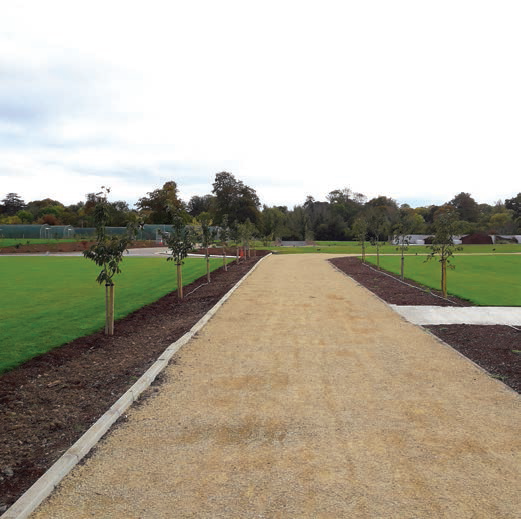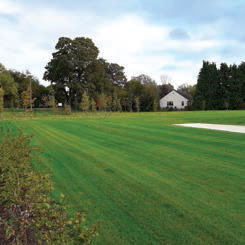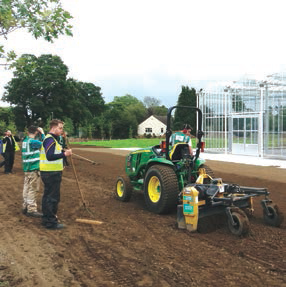John Mulhern explains how students and staff had to take extreme action to save the significant landscape investment made at Ashtown
Over the last 18 months the landscape of Ashtown campus has been transformed with the planting of over 170 trees, complemented by drifts of perennials, shrubs, grasses and seasonal bulbs. Students from level 5 to level 7 were at the forefront of this great work, where they got to combine the knowledge learned in the classroom with practical skills training.
Their hard work was tested when Mother Nature decided to show us who’s in control by providing one of the worst spring seasons on record, coupled with a summer of prolonged drought. These conditions are anything but favourable to young vulnerable plants trying to establish.
Watering was carried out only when required and kept to a minimum. The effects from these adverse conditions were minimised by ensuring that best planting practices were implemented. While planting the larger trees throughout Ashtown, the perforated pipe was placed under and around the rootball of each tree with an inlet located just above ground level. This allowed for water to make direct contact with the rootball in a more efficient and effective manner, providing deep watering over the entire root system as opposed to surface watering. As the soil moisture levels were extremely low, surface watering would have resulted in the runoff, with water penetration being minimal and insignificant to the trees. Drip irrigation systems were installed on the smaller trees to ensure water was applied efficiently when required. A thick layer of mulch was also placed around the trees to retain moisture by reducing evaporation. Having implemented and demonstrated these best practices to our students, 170 trees are now displaying amazing autumn colour.
Reseeding of new lawn areas took place in early summer and as Sod’s law would have it, the drought followed. There was no major inconvenience as the seed just lay there until the conditions were favourable and eventually when the rain did fall, the seed germinated and lawns appeared. Over 10,000 Nepeta racemosa ‘Walker’s Low’ and Molinia ‘Edith Dudszus’ were planted by students along the main avenue of the campus which was an enormous task. A thick layer of bark mulch was applied over the entire planted area in early spring to a depth of approximately 15cm which undoubtedly saved the plants as they were not watered throughout the prolonged dry period or indeed at any stage since planting. Nepeta is a very forgiving plant in an array of conditions so our choice of planting worked well in terms of coping with what was thrown at it. By carrying out fundamental maintenance tasks such as mulching we provided the plants with the best chance of establishing which is paramount for any young plants. It also permitted us to be prudent with our time management, ensuring our time was not spent weeding or watering during a very demanding and busy period.
MANAGING THE TEAGASC TURFGRASS TRAINING ACADEMY IN STRESSFUL CLIMATIC CONDITIONS
The extremes of the various weather features experienced in 2018 presented many challenges in the management of our recently constructed turfgrass academy in Teagasc Ashtown. Firstly we had the wet and very cold weather which dominated the first three months of this year, culminating in the heavy snows of February and March. This resulted in a very late start to the grass growing season, causing us to revise both our nutritional programme and our cultural management practices. But nothing could prepare us for the high temperatures and drought experienced from the end of May until early August. The problem was compounded by the overall shortage of water on the campus and because our new automatic irrigation system was not installed until the end of June. By that time we had a lot of very brown grass in the turf academy, but thankfully the fine fescue grasses which dominate the three golf greens showed their great tolerance of drought and remained fairly green throughout. In keeping with our approach to the sustainable management of the facility, our activity in recent weeks has been geared to set down a good foundation for the winter and next year. Our nutritional programme is based on liquid fertilisers and biostimulants with potassium, magnesium, iron, manganese and small amounts of nitrogen being applied on a regular basis. In recent days, greens have been hollow cored and top-dressed with sand and we have begun to mow less frequently and less intensively. It is good to see both staff and students on the Ashtown campus using this new facility. Two very important industry events were held on the turf academy in the autumn. ICL / Syngenta hosted a Turf Science Lite event in September, and in early October Reel Tech Ltd launched their new range of Baroness Turf equipment.
TRAINING
The new term has started very positively here in the College of Horticulture with numbers up in all courses both full and part-time. Our part-time courses complement the full-time courses across the certificate and advanced certificate level with both groups mixing seamlessly. We continue to work on the forthcoming apprenticeship programme with our stakeholder groups in applied horticulture and sportsturf. It is the intention of Teagasc to be able to launch these two apprenticeships with the relevant sectors in autumn 2019. This training model in apprenticeship will greatly enhance the flow of well-qualified people into the industry which is eagerly awaited. Recently the college has run successful industry training days for stakeholders from the turfgrass sector and the amenity landscape sector in both Teagasc Ashtown and the Teagasc education centre in the National Botanic Gardens. We have also held two tailored training days with staff from Peter O’Brien and Sons Landscaping LTD. The days are part of an ongoing initiative between us to assist contractors with building plant knowledge. The college embraces this training also as a pathway of engagement with current practitioners in the industry and our own staff.
Any further queries on full time, part time or industry short course based training in Horticulture should be directed to John.Mulhern@teagasc.ie or the college office at 01 804 0201. ✽












